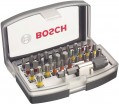TH bits sizes
The sizes of the Torx Security bits included in the set and the number of bits of each size.
For the bits themselves, see above. The size in this case is indicated by a conditional number; the larger the number, the larger the slot for which the nozzle is designed. The specific size to which this or that number corresponds can be clarified according to special tables. If there is more than one bit, the number of bits is specified after the size. For example, the entry "TR7, TR8x2" means one bit of TR7 and two bits of TR8.
Tool storage
Way of storing tools, standardly provided by the kit.
— Plastic case. Hard case made of plastic with nests for items included in the set; nests can be provided both in the lower half and on the lid. The case can be useful not only as a storage / transportation device, but also as an element of space organization directly at the workplace. Solid walls reliably protect the contents from both contamination and contact with foreign objects. Plastic cases are less durable than metal cases, but in most cases this difference is not critical.
— Metal case. Metal cases are in many ways similar to the plastic cases described above. This material is considered more durable than plastic, but in fact this difference is insignificant — especially considering that rather thin metal is used for tool cases. Another feature of such storage is tool nests: in metal boxes, they can be very conditional, or even absent altogether.
— Rail. The rail in this case is a clip plate, usually metal, on which nozzles are placed in a row. They are inserted into the longitudinal groove and fixed by the landing square. It is best to remove the nozzles from the rail in turn, shifting to the edge of the groove. Therefore, this method is mainly suitable for long-term storage, and not for everyday placement in the workplace.
— Cassette. This term can refer to several types of packaging. So, some cassettes look like small boxes with nests for objects and a transparent lid; ot...hers have the appearance of an oblong trough, in which nozzles are placed side by side; still others look like a cylinder with holes in the end, playing the role of nests. The common features of all cassettes are: firstly, small size (this is how cassette boxes differ from cases); secondly, the presence of clearly allocated places for each item.
— Blister packaging. Packing made of dense transparent polymer, complemented by a backing of paper or transparent material. Note that many blisters are disposable and are designed only for the delivery of the kit to the end customer; after extracting the contents, such disposable packaging becomes unusable.
— Plastic holder. Plastic bar with protrusions on which complete nozzles are put on. Holders are not as convenient for long-term storage as cases, because they do not cover the contents of the kit from contamination. On the other hand, this is a rather convenient option for the daily organization of the workplace — each item is removed from the holder independently of the others, and the holder itself is relatively small.
— Lodgement. Open tray with recesses for individual items. Note that not all lodgements are suitable for carrying without additional packaging: items in the nests may not lie very tightly and fall out when the tray is turned over. Trays are slightly better for long-term storage than plastic holders, and are also handy for organizing your workspace.
— Case. A soft case, usually, made of dense fabric and with nests for individual items. However, “soft” is a relative term: some cases have hard walls and resemble boxes. A rather specific type of packaging that is rare.
— Cardboard box. Cardboard is inexpensive, but fragile and wears out quickly. Therefore, cardboard boxes are designed rather for the role of “sales packaging”: sets are delivered and sold in them, but after unpacking, such containers are poorly suitable for further storage.

